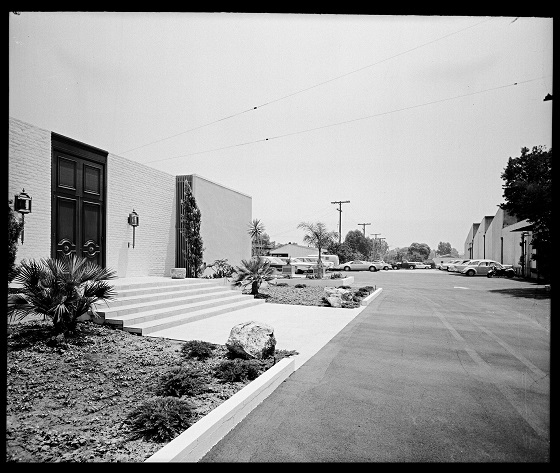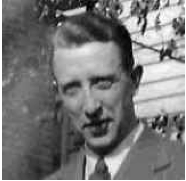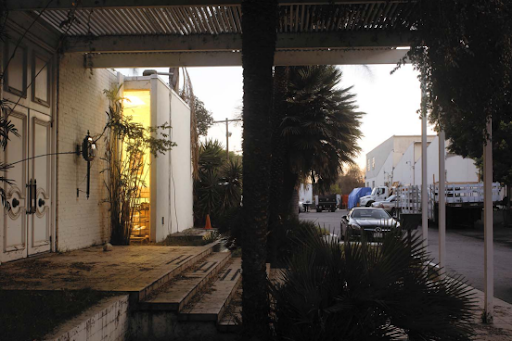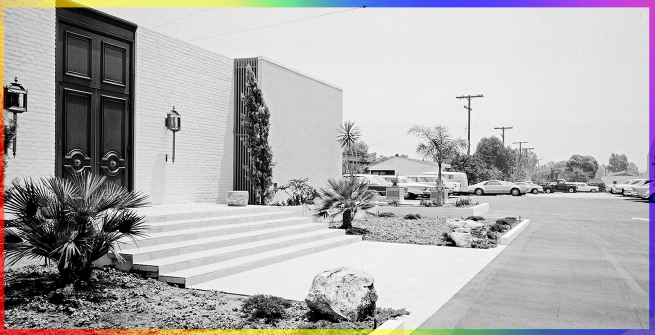Los Angeles has over 1,200 Historic-Cultural Monuments, yet only a dozen have been designated because of their association with the LGBTQIA community.
This post is part of a series we put together for Pride Month that tells the stories of historically and culturally significant LGBTQIA places across Los Angeles and the grassroots efforts to save them. You can also participate in the LGBTQIA Los Angeles Challenge to explore more landmarks and hidden gems that tell the story of L.A.’s diverse LGBTQIA heritage.
Part One: The Van Luit Complex
The Van Luit factory and showroom housed the Van Luit wallpaper company, the first wallpaper manufacturing business in California, from 1950 through the 1970s. Van Luit & Company was renowned for its high-quality wallpaper and for its innovative methods of production and distribution. Albert Van Luit created a diverse and welcoming workplace, hiring both LGBTQ and immigrant employees at a time when this was not the norm. The efforts of the community group Atwater Village Always led to the designation of the complex as Los Angeles Historic-Cultural Monument #1116. Two members of that local community group wrote this piece on the history and legend of the Van Luit Complex.
Our story is set in North Atwater Village where 50% of land use is reserved for manufacturing and industrial use. Over time, industry has transformed to include biotechnology, and film & TV recording studios, as well as vendor businesses that go along with the entertainment industry. An original entertainment vendor, Scenic Expressions (a transportation and set storage company), started its business in North Atwater 35 years ago. However, rather than being situated further north in the area zoned for industry, it resides within the residential area of North Atwater. Surrounding residents hardly notice business operations as it is surrounded by trees and foliage, and its frontage is set back from the street. Even flatbed trucks and trailers hauling set flats onto the facility are no more obtrusive than the daily Parks and Rec vehicles traveling the same street to their maintenance yard. The company has always been friendly; in the past, they hosted Neighborhood Watch meetings.
Every neighborhood has a Rumor Mill. When ours started generating rumors about a 60-unit small-lot subdivision, it was too preposterous to believe. A development that large within the Equestrian District? Unthinkable! When the developer’s representative was scheduled to present their plan to our Neighborhood Council, some of us attended, but we forgot our pitchforks. It was that kind of meeting.

What We Did
Following that meeting, the representative escorted the community on a Saturday morning tour of the Albert Van Luit Complex. During the tour, a community member asked whether there was any historic significance associated with the two buildings. When he denied any historical significance and suggested we look into the significance of the bridle trails, he had thrown down the gauntlet.
We were galvanized. We organized and held our first meeting on Mother’s Day facilitated by an urban planner. Initially, we sought support from City planning officials to no avail. Nevertheless, we forged ahead, branding our group by giving it a name, writing a mission statement, and creating a website and a logo. Over a span of three months, we created a petition, hired historians to dig into the history of the property, hired a land-use legal firm after interviewing several others, consulted with a public relations specialist, pushed successfully for the revocation of two demolition permits, followed up on our historian’s research with a trip to UC Santa Barbara’s Edward Killingsworth collection, also scouring resources at the Huntington Library, and held our first of several fundraisers. Every step forward increased our excitement as we learned more about the history of a world-class wallpaper designer and his factory. Albert Van Luit also happened to be a closeted gay man and an equestrian.

What We Discovered
Not only did we learn about the manufacturing of wallpaper and the development of the wallpaper industry, but we also learned about the many patents under Albert Van Luit & Co., two of which revolutionized the wallpaper industry—a drying apparatus that preserves the high quality of the wallpaper, and the means for unidirectional photo enlarging and reducing. We learned the importance of daylight sawtooth buildings in Los Angeles, and in particular, the importance of this type of building for the manufacturing of wallpaper. We learned about the architect, Edward Killingsworth, and his meteoric career following his dealings with Albert Van Luit. We learned (via a dearly departed research member of our team) that Van Luit chose Edward Killingsworth in 1965 over Neutra or Schindler, whose works were found throughout Silver Lake, an adjacent neighborhood. One of Killingsworth’s great skills was his site responsiveness, a design element evident not just in the design of Van Luit’s on-site showroom, it’s how Killingsworth oriented the entrance toward the factory’s entrance, hearkening one supporter’s observation, “form follows function.” Research at UCSB turned up architectural plans, Plot Plans, and archives of agenda notes between Killingsworth’s team and Albert Van Luit & Co. Over twenty residents mentioned in their letters of support that despite “walking the dog” daily past the Complex, or living abutted to the Complex, the business at the Complex has gone unnoticed (as a result of the factory’s 20-foot low aspect, tree plantings, and setbacks). Just as many or more equestrians commented on how the Complex has provided a sense of safety for riders. Every stone overturned revealed a new discovery, a new name, someone who might know more about some aspect of what was happening in the factory, someone who might have known Albert Van Luit. And we did!

The People
When LGBT individuals were seen as “sex perverts” during the McCarthy era following World War II, employees and colleagues of Albert Van Luit who passed through the gates of the Complex, could feel safe to work and socialize. Immigrants from as far as Egypt and Austria, and as near as Mexico and Argentina found job security, living wages, and promotions from within at Van Luit’s wallpaper factory. According to Virginia Knight, “Mr. Van was like a Big Daddy to all the employees; he was like a father figure, but not authoritarian. He was like the father some of us wish we had, especially for the immigrants and disenfranchised.”
From Virginia Knight (AVL Interior Designer), Hector Caresia (AVL Printer), William Wells (AVL Printer), Jim Grumbley (AVL Sample Dept), Bud Gaydos (AVL Shipping), and Yvonne Haley (Owner of Van Luit’s former residence abutting the AVL Complex), as well as friends and neighbors, we learned about the inner workings of the factory, the design and manufacture of wallpaper, and mostly and with great reward, we learned about the people who worked and strived for excellence with Albert Van Luit, aka, Mr. Van. They helped us get to know Mr. Van, whose ultimate working principle was collaboration and always with deference, crediting others for his accomplishments.
From Virginia Knight we learned how difficult it was to be gay in this era as she describes her internalized homophobia, and how she found her “home” in Albert Van Luit’s haven for disenfranchised minorities. “Everybody was gay,” said Virginia, “Mr. Van was very closeted, and he wasn’t supposed to be out. He even married, but it was a sham. But Bob and Buzz and Carol, and Lee Tillory…In the 50’s it wasn’t ok.” We learned about Carol and her partner; a lesbian couple who were expert silk screen designers and creators. We learned of the high esteem Van Luit held for the silkscreen washers (“there were no grunt jobs” says Virginia, as silk screens were “the crown jewels” of Van Luit’s operation. Argentinian Hector Caresia shared old polaroids, helping others remember names that he could not; he also testified to the stability of the factory during the 1971 San Fernando earthquake. Will Wells, who started work at the factory a few years after Van Luit died, paints a stark picture of the difference it made to have Albert Van Luit at the helm; he pays homage to “all the ‘lifers,’ whether LGBT, Latino, or Egyptian, who were loyal to, honored by working for, and believed in the company Albert Van Luit created.” We learned that Van Luit’s lover, Art (Arturo) Mendez, a professional dancer, also worked as a factory supervisor in later years. Yvonne Haley met and spent time with Art after she purchased and moved into Van Luit’s home next to the factory. From Jim Grumbley we experienced how he developed a passion for exceptional wallpaper through his lens of an expert paperhanger; we also learned how his exposure to gay people in the work environment changed his perspective of the LGBT population. From Jim’s high school friend, now clinical research nurse, Bud Gaydos, we learned what it meant to him to ship “the Cadillac of wallpaper” all over the world, and the sense of being part of “a big team, working together, striving to do our best.”
Finally, in the words of Jim Grumbley, “I can’t help but wonder about the many others that passed through Albert Van Luit’s Complex, and whether their lives were as profoundly affected as mine was. I am proud to be a part of this history, and I hope by preserving the factory, generations to come will learn about Van Luit, about his passion for excellence, and how his kind of leadership in the commercial arts-inspired folks like me.”
We, who are inspired by the rediscovery of Albert Van Luit & Co., feel the same. We are deeply grateful to all those who shared their stories and described like Jim, how profoundly affected they were by the inspiring and diverse work environment, and the opportunity to be a part of creating timeless art. We are especially grateful to Virginia ‘Ginny’ Knight (now dearly departed), who trusted her story us with, breaking the seal of silence established during the McCarthy years (for safety’s sake). Were it not for her (and the other stories that corroborate hers), the LGBT cultural component of the historic-cultural nomination would not have tied the historic buildings to the phenomena that was going on inside them, fleshing out the whole picture that includes the element of a “safe haven” so poignantly described by Ginny in her recording for the Cultural Heritage Commission. Ginny sums it up, “Mr. Van made a safe place for us to work, an environment for us to be who we were, to be creative.”


—Written by Kelly Blanpied and Jackie Sloan, with permission from the Atwater Village Always Committee.
Contact Atwater Village Always for more of the story: atwatervillagealways@gmail.com
